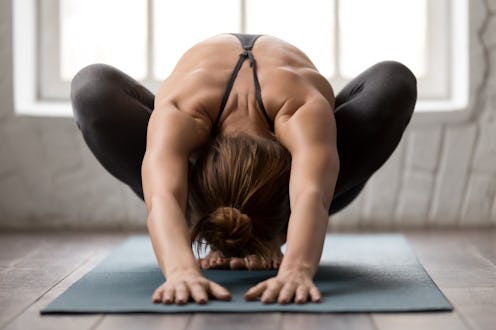Fitness
The Primal Movement Fitness Trend Is Taking Over In 2023
Get ready to bend and squat and crawl.

When was the last time you crawled across your living room? Or, better yet, stood up from your desk to stretch and twist your body? If it’s been a minute, it might feel good to add more primal movements into your routine so you can bend and move in all the ways humans were meant to.
That’s the idea behind primal fitness, a workout modality that’s poised to be a major trend this year, according to the Pinterest Predicts 2023 report (and the over 1.5 billion views it’s already racked up on TikTok). It involves engaging in all the natural movement patterns that have been a part of human mobility and motion for hundreds of thousands of years, says Dorian Cervantes, an instructor with obé Fitness. Think squatting, lifting, pushing, running, and carrying.
Primal movement patterns are divided into seven categories: push, pull, squat, hinge, lunge, rotation, and locomotion (aka gait), explains Cervantes. Basically, if the movement gets you out of a modern-day sitting position, it likely counts as primal. The goal is to avoid a sedentary life and get back to the basics when it comes to moving around, all so that you can feel your best.
While it sounds simple, Cervantes notes that the primal movement trend is taking off for a reason. “We as a generation are more health conscious, and we have a better understanding of the importance and benefits of movement and exercise, especially post-lockdown,” she says. “I think we genuinely just want to feel better, and finally people are starting to catch on that you can feel great by moving your body.” And that doesn’t necessarily require you to go all-out with HIIT workouts every single day. Keep scrolling to learn more about how primal movement fitness prioritizes healthy mobility over anything else.
The Benefits Of Primal Movement
Take a look at the primal movement trend and you’ll notice that it involves a lot of bending, stooping, lunging, and squatting. When you do these movements on a regular basis, you start to feel better from the top of your head to the tips of your toes.
Here’s why: “Primal movements can help with posture, balance, and stability because they intentionally move your body in a way that engages more musculature and it moves the body as a whole, rather than through isolated joint movements,” says ACE-certified personal trainer TJ Mentus. It’s why these kinds of exercises are the perfect antidote to tech-neck and other musculature aches and issues that happen when you hold the same position all day.
Moving in a primal way is also good for your joints, Mentus tells Bustle, because it improves blood flow throughout the body and trains all your muscles to become more balanced. The end result? Everything runs more smoothly. According to Mentus, it can even expand the types of activities you’re able to do as your mobility improves and you start to feel stronger and more stable.
It helps to think of primal movement as a form of functional fitness — the kinds of workouts that aim to help your body function better in everyday life. By incorporating primal movements into your routine, it’ll eventually be easier to stoop down to pick up your dog, reach up to grab a book off a high shelf, or push open a heavy door. “Primal fitness focuses on moving our bodies how they were designed to move in nature,” Mentus says. “The idea is that using more primal movements will help to reverse the negative effects on our bodies and posture that happen from our modern lives, which includes a lot of sitting and lack of moving in general.”
Beyond the physical benefits, primal movements are also great for your mind/body connection, says Cervantes, since they engage multiple muscle groups at once. It feels good to get up, stretch, and get “unstuck” by moving your whole self the way your ancestors did.
What Do Primal Movements Look Like?
To add more primal movements to your day, you can move through a series of deep squats, pull-ups, push-ups, and forward lunges, Cervantes says — all super basic exercises. You can also focus on functional moves like rotating chops and tricep dips as well bear crawls and other exercises that get you down on all fours.
By moving through multiple planes — like side to side, up and down, etc. — your body will start to operate more efficiently on top of becoming more physically strong, Mentus says. “This is also good for our mental and emotional health,” he adds. “Getting in touch with primal movements is one way to give our bodies what they need to thrive.”
Studies referenced:
Huang, J. (2022). Effects of Exercise-Based Interventions on Functional Movement Capability in Untrained Populations: A Systematic Review and Meta-Analysis. Int J Environ Res Public Health. doi: 10.3390/ijerph19159353.
Kett, A. R. (2020). Sitting for Too Long, Moving Too Little: Regular Muscle Contractions Can Reduce Muscle Stiffness During Prolonged Periods of Chair-Sitting. Frontiers in Sports and Active Living, 3. https://doi.org/10.3389/fspor.2021.760533
Pacheco, MM. (2013). Functional vs. Strength training in adults: specific needs define the best intervention. Int J Sports Phys Ther. PMID: 23439782; PMCID: PMC3578432.
Sources:
Dorian Cervantes, instructor with obé Fitness
TJ Mentus, ACE-certified personal trainer